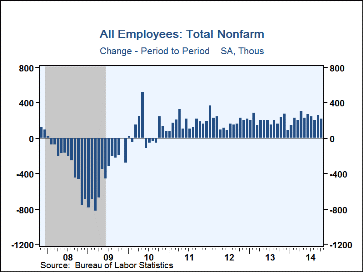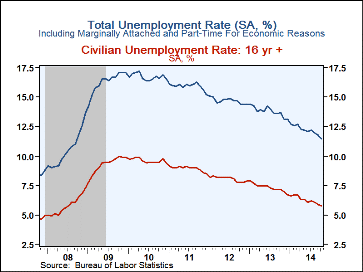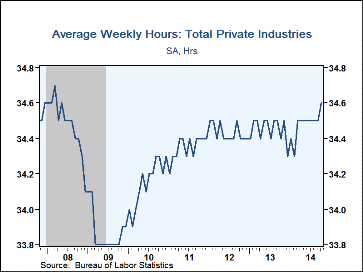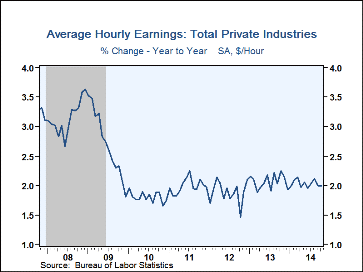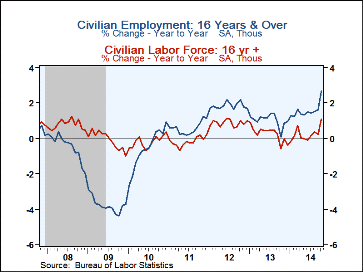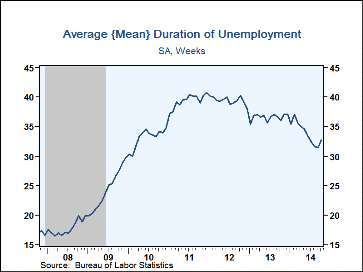 Global| Nov 07 2014
Global| Nov 07 2014U.S. Payrolls Grow Moderately; Unemployment Rate Hits 2008 Low
by:Tom Moeller
|in:Economy in Brief
Summary
Nonfarm payrolls grew 214,000 during October (1.9% y/y) following upwardly revised increases of 256,000 and 203,000 during the prior two months. The gain fell short of expectations for a 230,000 rise in the Action Economics Forecast [...]
Nonfarm payrolls grew 214,000 during October (1.9% y/y) following upwardly revised increases of 256,000 and 203,000 during the prior two months. The gain fell short of expectations for a 230,000 rise in the Action Economics Forecast Survey. The unemployment rate edged down to 5.8%, its lowest level since July 2008. Expectations had been for 5.9%. The overall jobless rate, including workers who were marginally attached or those employed part-time for economic reasons, fell to 11.5%.
From the payroll employment survey, job market improvement remains broad. During the most recent three months, employment grew in 68.8% of industries. Over the last twelve months, 77.7% of industries added employees. In the factory sector, hiring improved in 59.9% of industries over three months while nearly two-thirds raised employment in the last twelve months.
Total employment grew 214,000 last month. Factory sector employment increased 15,000, the strongest gain in three months. Construction jobs, however, grew 12,000, the weakest rise since June. The 181,000 increase in private service sector jobs was down a bit from September, but y/y growth remained at 2.2%, where it's been since 2012. Jobs in leisure & hospitality industries grew 52,000 (2.6% y/y), the strongest gain in twelve months. Jobs in the education & health area improved 41,000 (2.0% y/y). Professional & business services employment grew 37,000 (3.5% y/y), the weakest gain this year, and retail trade employment advanced 27,100 (1.6% y/y). Transportation & warehousing jobs grew 13,300 (3.4% y/y), wholesale trade gained 8,500 (2.2% y/y) and jobs in the financial area improved 3,000 (1.1% y/y). In the government sector, payrolls continued the modest rate of improvement seen all year with a 5,000 increase (0.3% y/y). This annual gain compared to declines in the prior four years. Local government hiring grew 7,000 (0.5% y/y), led by growth outside of the education sector. State government hiring inched up 1,000 (0.2% y/y) but federal government employment fell 3,000 (-0.8% y/y).
The weekly average hours worked improved to 34.6, the longest workweek since May 2008. The factory sector workweek held m/m at 40.8 hours, down slightly from earlier this year. The construction sector workweek ticked up to 39.2 hours, the high point for the economic expansion. The private service sector workweek held m/m at 33.4 hours, also the high of the recovery. Professional & business services recovered to the high of 36.3 hours.
Average hourly earnings ticked 0.1% higher, leaving the y/y advance stable at 2.1%. A 0.2% rise had been expected. Goods producing industry earnings gained 0.3% (2.3% y/y) led by a 0.4% rise (1.9% y/y) in factory sector earnings. That y/y advance was down from 2.6% reached early this year. Private service sector earnings were unchanged for the second month while the 1.9% y/y rise was below the 2.4% high reached early last year.
From the household employment survey, the fall in the unemployment rate to 5.8% was the result of a 683,000 rise (2.6% y/y) in employment and a 416,000 improvement (1.1% y/y) in the labor force. The y/y rise in the labor force represented an uptick in the participation rate to 62.8%. The population grew 0.9% y/y while the number of people not in the labor force grew a lesser 0.7%. The percentage of the unemployed 52 weeks or more was 23.2%, down from the 31.4% high during 2011.
The average duration of unemployment ticked up m/m to 32.7 weeks, but remained down from 36.6 weeks for all of last year and from 39.4 weeks in 2012. The median duration of 13.7 weeks was down from the 21.5% high in 2010.
By educational attainment, the 7.9% rate of unemployment for those without a high school diploma exceeded the 5.7% for graduates but no college. Those with less than a bachelors degree saw 4.8% unemployment while college grads realized 3.1% unemployment.
The figures referenced above are available in Haver's USECON database. Additional detail can be found in the LABOR and in the EMPL databases. The expectation figures are from Action Economics and are in the AS1REPNA database.
Population Aging, Migration Spillovers and the Decline in Interstate Migration from the Federal Reserve bank of New York can be found here.
| Employment: (M/M Chg., 000s) | Oct | Sep | Aug | Y/Y | 2013 | 2012 | 2011 |
|---|---|---|---|---|---|---|---|
| Payroll Employment | 214 | 256 | 203 | 1.9% | 1.7% | 1.7% | 1.2% |
| Previous | -- | 248 | 180 | -- | -- | -- | -- |
| Manufacturing | 15 | 9 | 3 | 1.4 | 0.7 | 1.7 | 1.7 |
| Construction | 12 | 19 | 17 | 3.9 | 3.3 | 2.1 | 0.2 |
| Private Service Producing | 181 | 208 | 178 | 2.2 | 2.2 | 2.2 | 1.9 |
| Government | 5 | 12 | 3 | 0.3 | -0.3 | -0.8 | -1.8 |
| Average Weekly Hours - Private Sector | 34.6 | 34.5 | 34.5 | 34.4 (Oct.'13) |
34.5 | 34.4 | 34.3 |
| Private Sector Average Hourly Earnings (%) | 0.1 | 0.0 | 0.3 | 2.0 | 2.1 | 1.9 | 2.0 |
| Unemployment Rate (%) | 5.8 | 5.9 | 6.1 | 7.2 (Oct.'13) |
7.4 | 8.1 | 8.9 |
Tom Moeller
AuthorMore in Author Profile »Prior to joining Haver Analytics in 2000, Mr. Moeller worked as the Economist at Chancellor Capital Management from 1985 to 1999. There, he developed comprehensive economic forecasts and interpreted economic data for equity and fixed income portfolio managers. Also at Chancellor, Mr. Moeller worked as an equity analyst and was responsible for researching and rating companies in the economically sensitive automobile and housing industries for investment in Chancellor’s equity portfolio. Prior to joining Chancellor, Mr. Moeller was an Economist at Citibank from 1979 to 1984. He also analyzed pricing behavior in the metals industry for the Council on Wage and Price Stability in Washington, D.C. In 1999, Mr. Moeller received the award for most accurate forecast from the Forecasters' Club of New York. From 1990 to 1992 he was President of the New York Association for Business Economists. Mr. Moeller earned an M.B.A. in Finance from Fordham University, where he graduated in 1987. He holds a Bachelor of Arts in Economics from George Washington University.


